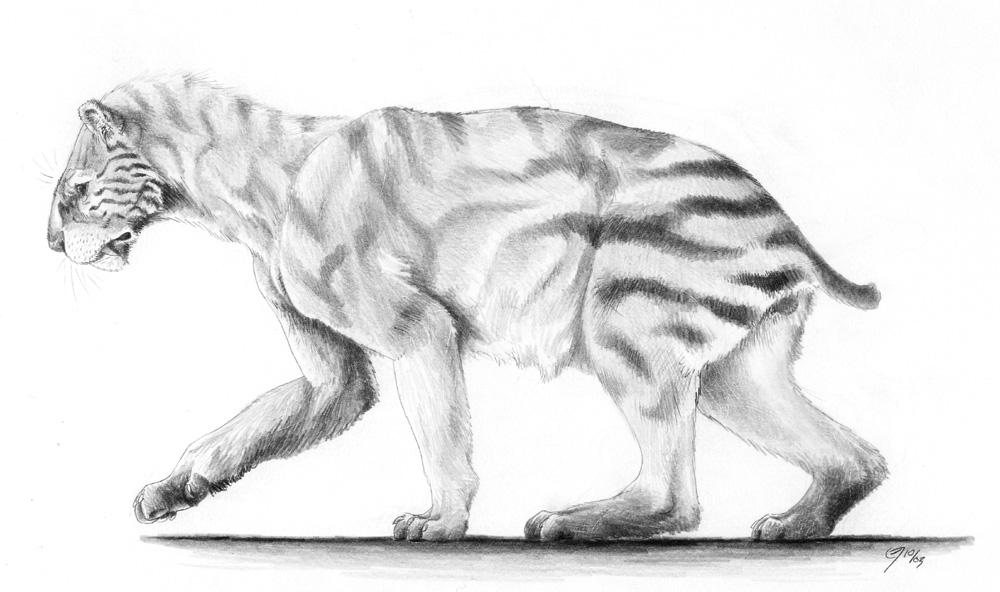Post by Infinity Blade on Apr 4, 2015 18:39:23 GMT 5
Xenosmilus hodsonae

© @ Qilong
Temporal range: Irvingtonian
Scientific classification:
Life
Domain: Eukaryota
(unranked): Unikonta
(unranked): Opisthokonta
(unranked): Holozoa
(unranked): Filozoa
Kingdom: Animalia
Subkingdom: Eumetazoa
(unranked): Bilateria
Superphylum: Deuterostomia
Phylum: Chordata
Infraphylum: Gnathostomata
Clade: Eugnathostomata
Clade: Teleostomi
Clade: Tetrapoda
Clade: Reptiliomorpha
Clade: Amniota
Clade: Synapsida
Order: Therapsida
Clade: Theriodontia
Clade: Eutheriodonta
Suborder: Cynodontia
Clade: Epicynodontia
Infraorder: Eucynodontia
Parvorder: Probainognathia
Superfamily: Chiniquodontoidea
Clade: Prozostrodontia
Clade: Mammaliaformes
Class: Mammalia
(unranked): Pegasoferae
(unranked): Zooamata
Clade: Holotheria
Superlegion: Trechnotheria
Legion: Cladotheria
Sublegion: Zatheria
Infralegion: Tribosphenida
Subclass: Theria
Clade: Eutheria
Infraclass: Placentalia
Subcohort: Exafroplacentalia
Magnorder: Boreoeutheria
Superorder: Laurasiatheria
(unranked): Ferae
(unranked): Carnivoramorpha
Order: Carnivora
Suborder: Feliformia
Family: Felidae
Subfamily: †Machairodontinae
Tribe: †Homotherini
Genus: †Xenosmilus
Species: †X. hodsonae
Xenosmilus hodsonae is a species of machairodontine, an extinct subfamily of felids. Xenosmilus was found in Florida, particularly in an area where numerous quantities of peccary fossils were recovered (dubbed "hog heaven"). It seems likely Xenosmilus preyed on peccaries. In terms of the morphology of its jaw apparatus, it was in a distinct group of its own from other sabertoothed cats. There were the dirk-toothed cats (eg. Smilodon) with comparatively long, slender maxillary canines and the scimitar-toothed cats (eg. Homotherium) with their maxillary canines shorter and broader than those of the aforementioned group. Unlike in Smilodon, there was no significant spacing between the maxillary canines and incisors in Xenosmilus and based on its jaw morphology, Xenosmilus would have killed its prey by biting off large chunks of flesh until the quarry died of exsanguination.[1]
References:
[1] www.wired.com/2011/10/cookie-cutter-cat-not-as-cute-the-name-sounds/
The above link contains scientific references in turn.

© @ Qilong
Temporal range: Irvingtonian
Scientific classification:
Life
Domain: Eukaryota
(unranked): Unikonta
(unranked): Opisthokonta
(unranked): Holozoa
(unranked): Filozoa
Kingdom: Animalia
Subkingdom: Eumetazoa
(unranked): Bilateria
Superphylum: Deuterostomia
Phylum: Chordata
Infraphylum: Gnathostomata
Clade: Eugnathostomata
Clade: Teleostomi
Clade: Tetrapoda
Clade: Reptiliomorpha
Clade: Amniota
Clade: Synapsida
Order: Therapsida
Clade: Theriodontia
Clade: Eutheriodonta
Suborder: Cynodontia
Clade: Epicynodontia
Infraorder: Eucynodontia
Parvorder: Probainognathia
Superfamily: Chiniquodontoidea
Clade: Prozostrodontia
Clade: Mammaliaformes
Class: Mammalia
(unranked): Pegasoferae
(unranked): Zooamata
Clade: Holotheria
Superlegion: Trechnotheria
Legion: Cladotheria
Sublegion: Zatheria
Infralegion: Tribosphenida
Subclass: Theria
Clade: Eutheria
Infraclass: Placentalia
Subcohort: Exafroplacentalia
Magnorder: Boreoeutheria
Superorder: Laurasiatheria
(unranked): Ferae
(unranked): Carnivoramorpha
Order: Carnivora
Suborder: Feliformia
Family: Felidae
Subfamily: †Machairodontinae
Tribe: †Homotherini
Genus: †Xenosmilus
Species: †X. hodsonae
Xenosmilus hodsonae is a species of machairodontine, an extinct subfamily of felids. Xenosmilus was found in Florida, particularly in an area where numerous quantities of peccary fossils were recovered (dubbed "hog heaven"). It seems likely Xenosmilus preyed on peccaries. In terms of the morphology of its jaw apparatus, it was in a distinct group of its own from other sabertoothed cats. There were the dirk-toothed cats (eg. Smilodon) with comparatively long, slender maxillary canines and the scimitar-toothed cats (eg. Homotherium) with their maxillary canines shorter and broader than those of the aforementioned group. Unlike in Smilodon, there was no significant spacing between the maxillary canines and incisors in Xenosmilus and based on its jaw morphology, Xenosmilus would have killed its prey by biting off large chunks of flesh until the quarry died of exsanguination.[1]
References:
[1] www.wired.com/2011/10/cookie-cutter-cat-not-as-cute-the-name-sounds/
The above link contains scientific references in turn.






